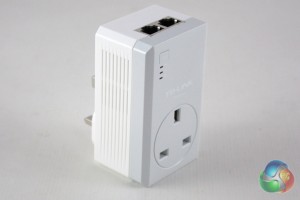
The adapters are quite large in size compared to other powerline network adapters, however they feature a pass-through for the power socket. This means that the socket can still be used while using the powerline network adapters, which could be useful for a number of users.
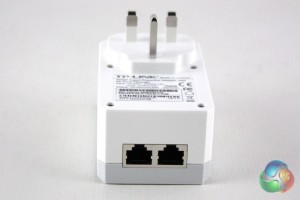
Perhaps the most significant differentiating factor of these adapters is the inclusion of two Ethernet jacks in each, meaning you can connect two devices at the other end without requiring a separate switch. This will be particularly useful for those users who have multiple devices in wireless dead spots.
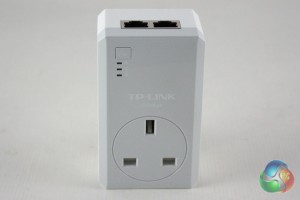
The adapters are finished in a combination of matte-white plastic (for the main body of the unit), and gloss-grey plastic for the main faceplate. On the front of each adapter we find a 3-pin power socket, as well as a pairing button and three LED indicators.
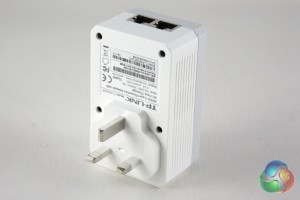
We find the two gigabit Ethernet ports on the top of the unit, meaning that the cables will protrude upwards from most power sockets.
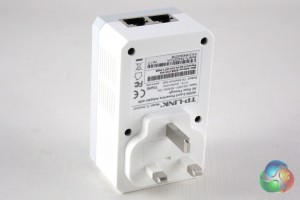
On the reverse side of each adapter, we find the 3-pin power plug alongside a label featuring model details, the MAC address and password.
 KitGuru KitGuru.net – Tech News | Hardware News | Hardware Reviews | IOS | Mobile | Gaming | Graphics Cards
KitGuru KitGuru.net – Tech News | Hardware News | Hardware Reviews | IOS | Mobile | Gaming | Graphics Cards



I have these, and they are pretty good for the money expenditure. The one downside I would comment on is they are stuck on 100Mbps Ethernet connections, when I was expecting 500Mbps. What you end up with is UP TO 500Mbps per second behind the socket depending on your house wiring.
My results differ to those of KitGuru though, as I can reliably get just shy of 100Mbps anywhere in the house. I have a feeling that this may be due to the house I rent only just being re-wired. The longest and weakest connection I can get knocks me down to 88Mbps, which is pretty good considering I get no wireless router signal at all in that part.
My biggest complaint is the area I currently live can offer up to 150Mbps broadband, meaning that now my current connection can no longer take full advantage of downloading files. With faster and faster broadband speeds, I feel like if this technology can not even equip 1Gbps Ethernet ports then it is going to quickly fall behind wireless routers using bridges to expand the signal.
Due to the router I am using, the wireless signal can be flakey on occasion and this is pretty useless if internet gaming, so this is a wonderful substitute to using the wireless. However I am currently looking into one of two upgrades to phase this out after only having it for 6 months for the sole purpose of taking full advantage of the larger internet connection I have here.
Also have a pair of these and my consensus is simple. You could use these for the ease of setup, or get to areas where radio signal dont seem to get; If thats your goal, this is a superb product.
If you use these for getting a higher performance, well, … you are going to have a bad time in most situations.
What i found with the ether-line kit I had, was that not only the performance was not that great when you went over breaker groups. But the ping was not at all stable. for example ping was around 25ms then it could go 400ms or over a second later and back to 25ms again after. And also turning appliances like tv’s, computers or something could effect the performance for a shot time. So its a great product for checking mail or browse the web but gaming is not recommended (nothing beats the wire! Ok fibre does ;))